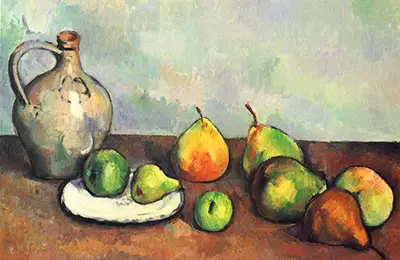 Buy Art Prints Now
Buy Art Prints Nowfrom Amazon
* As an Amazon Associate, and partner with Google Adsense and Ezoic, I earn from qualifying purchases.
This particular Still Life perfectly highlights the fine balance that Paul Cezanne created somewhere between Impressionism and the fresh outlook of Cubism that would soon begin to emerge within the art arena at this time.
The Pitcher and Fruit are clearly defined by layer upon layer of colour and strokes that slowly build the light and depth that we see within these objects. Despite this clearly being a Still Life created through intense observation, it still captures the unique style that Paul Cezanne portrayed as he explored the world of recreation and perception. Painted in 1894, Pitcher and Fruit formed part of his later and more established career and you can see this in the confidence used in both colour and form.
There is a slow and gentle approach taken throughout this work towards a more geometric portrayal of what Paul Cezanne observed. The simplicity of this Still Life leaves great scope to study the oil and its manipulation in great detail. It is quintessential of his work at this time, having moved well beyond the landscapes that he created in his earlier career. This work reflects the depth of Provence and the impact that his surroundings had on his final period.
By this stage of his painting career, Cezanne had clearly established a departure from the earlier landscapes that were inspired by his relationship with Camille Pissarro. This chapter of his life was largely about complete immersion in his works, and this is clear when you study the thickness of the paint and the clear contrast between the colours used. There is deliberate decision in each placement of colour and stroke, all incredibly thoughtful, conscious and designed to give the viewer a rounded sensation of Cezanne's view.
He captured touch and smell as well as sight. Despite there being clear detail and depiction of the objects in front of him, there remains an ambiguity and a loose candor in his style that leaves room for interpretation and creative analysis. Cezanne was renowned for his belief that every painting secured a specific moment in time, and each brush stroke had a distinct purpose in the creation of his Still Life paintings. Pitcher and Fruit is a true reflection of the method that Cezanne spent years developing and perfecting through every period of his life, while avoiding the more figurative style that impressionists before him had sought after through their more controlled composition.




